Ladue High School
Best high schools list out
06/10/09 18:38 Categories: Assessment
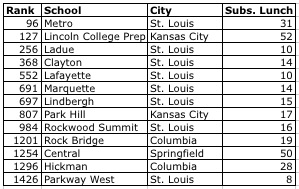
The perennial Newsweek best high school list compiled by Jay Mathews is out again. Valid criticisms of the list may be made, but the criteria is clear, is easy to understand and has changed the education landscape.
Only 13 schools from Missouri made the list, but at least that is up one from last year. In St. Louis Eureka dropped off the list, but Parkway West made it.
Kansas City only has one non-selective school on the list versus seven for St. Louis. There are, however, four high schools on the list on the Kansas City, Kansas side. Both high schools in Columbia made the list, which is impressive. The Springfield high school with 50 percent on subsidized lunch that made the list is not, as far as I can tell, selective. I believe that is the high school closest to the university, which may skew the subsidized lunch demographics, but those numbers are still impressive.
In 2005 St. Louis schools dominated the 10 schools from Missouri that made the list with only Lincoln College Prep, Hickman in Columbia and Park Hill in Kansas City rounding out the list. Lafayette in St. Joseph made the list in 2006, which would be nice to see return.
I think the geographical map of the top 1300 schools is interesting with a sea of blue on the coasts and in Florida.
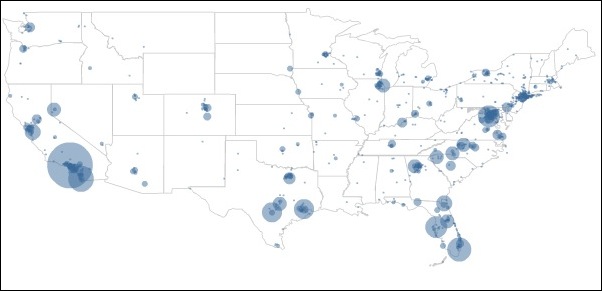
I zoomed in on Missouri and the surrounding states, which show blue in the urban areas with some pinpricks in some college towns.
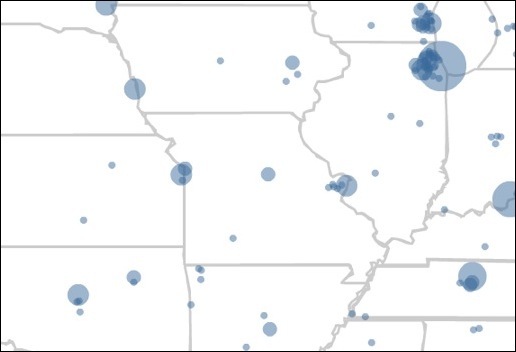
With Missouri Virtual Instruction Program offering AP courses (pdf), students in rural schools now have more opportunities to take advanced classes. I would like to see more rural schools make the list.
Schools have to continually increase the percentage of students taking AP/IB exams just to stay on the list. For example, Ladue improved its index number from last year but dropped in rank. This is meant to be a “race to the top,” where the top means access to challenging courses for as many students as possible.
A new, non-researched phenomenom has begun in which some schools are all-out embracing the AP courses as a challenge for struggling students in coursework that doesn’t require prerequisites.
The rise of high-participation, low-passing-rate AP schools like Bell and Hogan has led NEWSWEEK this year to put them in a separate category, the Catching-Up list, for schools that have met the NEWSWEEK standard for college-level test participation but have AP passing rates below 10 percent. Once such schools pass the 10 percent passing mark, they will have about the same number of passing tests as the average American school, where passing rates are higher but participation is much lower. (AP Programs as Educational Shock Therapy)
Two high schools in Kansas City are using this approach. We’ll watch to see how they do next year.
Missouri ranges from 10 to 13 schools on the last from year to year. Next year, I would like to see that change and blown away.
Why go private? Income? Religion? Ivy League?
12/18/07 15:43 Categories: Private Schools

Region plays a large role in the private school rate as Mehlville and Affton have a higher private school rate than wealthier west county districts. It’s a Catholic area, baby! (Lutheran South may have a role in the numbers for Affton.)
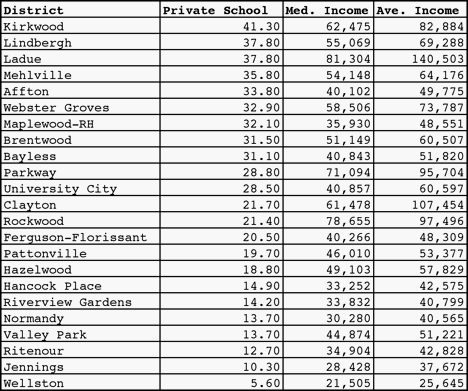
My theory is that the private school rate is dependent on multiple factors such as tradition, income and strong private school presences.
Ladue and Clayton are often considered sister schools with similar test scores, rankings, size, finances etc. However, the private school rates differences are striking. Yes, CBC moved to west county, but that was after the 2000 census. (Will these numbers change greatly in 2010?) I would have to dig more to figure out what Clayton and Rockwood have in common that is different than Ladue. I don’t know if Clayton’s numbers are related to the high number of people who walk or ride their bike to work, but I imagine Ladue’s high numbers are related to the two Ivy league feeder private schools within its borders. This is the land that inspired Confessions of a Prep School Mommy Handler by Wade Rouse.
Yes, of course, there’s a general correlation to income although the exceptions are more interesting.
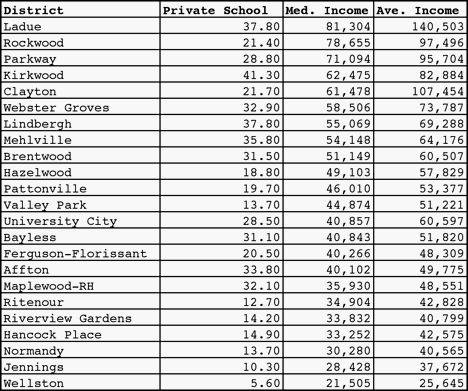
Look at Hazelwood and Brentwood with similar median incomes but different private schools rates or Affton and Ferguson-Florissant. I think the North County region just doesn’t have the tradition of attending private schools at the same rate. It’s not income there.
Why is Lindbergh’s private school rate (top 3) higher than it’s median income or quality would lead someone to hypothesize? I’m going back to the Catholic tradition.
Why is Kirkwood, a high quality school district, the number one private school sender? It’s not in the top three wealthiest by median or four by average. It’s numbers are more in line with Webster or Lindbergh. By tradition I would have put it with Webster, but, apparently, it aligns more with Lindbergh.
I have so many ideas for more posts now—how about that ranking of school districts by how many people go to work by walking or biking? Is there any significance that I can pull out from that? Who knew I could find census data so entertaining.